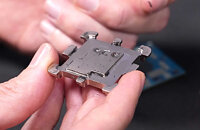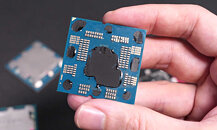- Joined
- Oct 9, 2007
- Messages
- 47,598 (7.45/day)
- Location
- Dublin, Ireland
| System Name | RBMK-1000 |
|---|---|
| Processor | AMD Ryzen 7 5700G |
| Motherboard | Gigabyte B550 AORUS Elite V2 |
| Cooling | DeepCool Gammax L240 V2 |
| Memory | 2x 16GB DDR4-3200 |
| Video Card(s) | Galax RTX 4070 Ti EX |
| Storage | Samsung 990 1TB |
| Display(s) | BenQ 1440p 60 Hz 27-inch |
| Case | Corsair Carbide 100R |
| Audio Device(s) | ASUS SupremeFX S1220A |
| Power Supply | Cooler Master MWE Gold 650W |
| Mouse | ASUS ROG Strix Impact |
| Keyboard | Gamdias Hermes E2 |
| Software | Windows 11 Pro |
A PC enthusiast in Romania bagged a good deal on a used AMD Ryzen 7 7800X3D processor they found on OLX, an P2P and B2B online marketplace. Only, this wasn't a 7800X3D. In fact, it wasn't even a processor—a complete paperweight. While you can't return stuff you found on OLX, for deals executed through the platform, there are fraud protection measures that can withhold funds to the seller. Unfortunately, as most P2P deals on platforms such as OLX or even eBay, the buyer and seller tend to negotiate a lower price to cut out the platform costs, and transact privately. This is how the enthusiast ended up with the dud. Der8auer discovered this, and offered to buy the processor from him.
Der8auer installed the processor and turned on the machine, and of course it wouldn't POST. So this isn't a case of a cheaper (but functional) processor being mislabeled and sold at a higher price. Der8auer then proceeded to de-lid the processor (remove its integrated heat spreader) to discover that it's a complete fake. There's not a shred of silicon under it. The IHS is designed to mimic the shape of the cIOD and CCD. Der8auer provided some quick tips on how to spot a fake: start with the substrate's solder-mask color—it should be green. The SMDs should have a thin sealant, which protect them in machines with extreme cooling solutions that can have condensation. The substrate itself is thin (under 1 mm), whereas the real chip has about 1.3 mm in substrate thickness. Lastly, look for font and alignment errors on the chip label, on the IHS itself. Be careful when looking for 7800X3D processors in the P2P market, ensure you either have a platform that can refund you, or use a mode of payment that can (such as Paypal). Find Der8auer's video in the source link below.



View at TechPowerUp Main Site | Source
Der8auer installed the processor and turned on the machine, and of course it wouldn't POST. So this isn't a case of a cheaper (but functional) processor being mislabeled and sold at a higher price. Der8auer then proceeded to de-lid the processor (remove its integrated heat spreader) to discover that it's a complete fake. There's not a shred of silicon under it. The IHS is designed to mimic the shape of the cIOD and CCD. Der8auer provided some quick tips on how to spot a fake: start with the substrate's solder-mask color—it should be green. The SMDs should have a thin sealant, which protect them in machines with extreme cooling solutions that can have condensation. The substrate itself is thin (under 1 mm), whereas the real chip has about 1.3 mm in substrate thickness. Lastly, look for font and alignment errors on the chip label, on the IHS itself. Be careful when looking for 7800X3D processors in the P2P market, ensure you either have a platform that can refund you, or use a mode of payment that can (such as Paypal). Find Der8auer's video in the source link below.



View at TechPowerUp Main Site | Source






